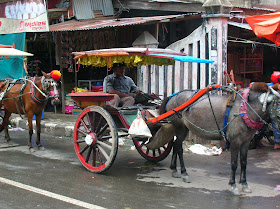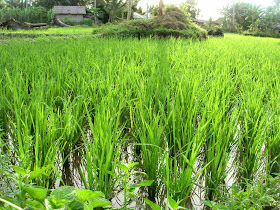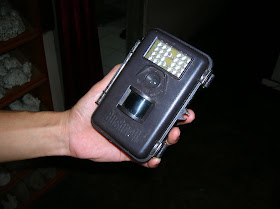 Well, another morning back in Hawai'i working on funding proposals and reports. That sort of stuff is pretty boring, but I do have time to take a break and tell you about a very interesting person and his organization in Indonesia. The person is my good friend John Taylor. We met about 3 years ago in Jogjakarta while studying Indonesian. John is an urban planner, this means that he is interested in the layout of cities and other public places and the actual geography of living. One of the most important roles of urban planners is to work with the public to identify community goals and then to help bring together community resources, like organizations, elected officials, and residents, to achieve those goals.
Well, another morning back in Hawai'i working on funding proposals and reports. That sort of stuff is pretty boring, but I do have time to take a break and tell you about a very interesting person and his organization in Indonesia. The person is my good friend John Taylor. We met about 3 years ago in Jogjakarta while studying Indonesian. John is an urban planner, this means that he is interested in the layout of cities and other public places and the actual geography of living. One of the most important roles of urban planners is to work with the public to identify community goals and then to help bring together community resources, like organizations, elected officials, and residents, to achieve those goals.  A remarkable things about John is that he looks for ways in which his professional skills can improve the lives of others. Towards that end, John founded a non-government organization (1) in the city of Solo (also known as Surakarta) in Indonesia.
A remarkable things about John is that he looks for ways in which his professional skills can improve the lives of others. Towards that end, John founded a non-government organization (1) in the city of Solo (also known as Surakarta) in Indonesia.John's NGO is called Solo Kota Kita, which means Our City Solo. The name gives you an idea of what the organization is about. You can check out Solo Kota Kita here. I had the opportunity to visit SKK's office in Solo and chat with some of the folks that work there last time I was in Indonesia, and I was really impressed with the kinds of work they are doing. The overall goal is to help residents of communities in Solo understand the strengths of their communities so that they can work togeth
 er and overcome challenges. Solo Kota Kita is about empowering local people so that they can understand what resources are available to them. This in turn strengthens the community and encourages people to work together to solve everyday problems. Solo Kota Kita gathers information from planning documents, the statistics bureau, and census documents and compiles them into easy-to-understand maps (mini-atlases). These mini-atlases provide information about education, sanitation, poverty, and other important aspects of community development (2). SKK also visits each of the communities to gather information directly from the residents. John told me that SKK is currently compiling photos from all of the more than 50 neighborhoods they work with in Solo, and the idea is to make a photo-essay for each one showing the unique character of each community.
er and overcome challenges. Solo Kota Kita is about empowering local people so that they can understand what resources are available to them. This in turn strengthens the community and encourages people to work together to solve everyday problems. Solo Kota Kita gathers information from planning documents, the statistics bureau, and census documents and compiles them into easy-to-understand maps (mini-atlases). These mini-atlases provide information about education, sanitation, poverty, and other important aspects of community development (2). SKK also visits each of the communities to gather information directly from the residents. John told me that SKK is currently compiling photos from all of the more than 50 neighborhoods they work with in Solo, and the idea is to make a photo-essay for each one showing the unique character of each community.Solo Kota Kita is a really dynamic and inspiring group of people. They use tools of geography everyday, including global positioning systems (GPS) and geographic information systems (GIS). GIS enables SKK to take a tremendous amount of information and present it in a way that easy for the user to understand and make comparisons. If you look at the map on SKK's homepage you can immediately start to see patterns. The best thing about it is that all of SKK's products are available for free to the public. This means that anyone can use the information and so it's truly democratic.
You can read a great article about Solo Kota Kita here.
1) A non-governmental organization (NGO) is an organization that doesn't make profit (like a business). Generally NGOs are voluntary and service-oriented and benefit the members and/or other groups in the community. NGOs are often founded to tackle community needs that are not being addressed by the government or private businesses. They do things ranging from research, information distribution, training, conservation, local organization, legal advocacy, and community service. Can you think of some examples of NGOs in Hawai'i? What kind of work do they do?
2) Download one of the mini-atlases from the SKK website. It should open up as a pdf on your computer. Use the atlas to answer the following questions:
a. What is the name of the neighborhood?
b. What are some of the advantages the neighborhood has?
c. How do you think the people in the neighborhood can benefit from these advantages?
d. What are some of the challenges the neighborhood is facing?
e. How do you think the community could work together to address these challenges?
f. What sorts of services are available in the neighborhood?
g. How do most people in the neighborhood make a living?
















































